Click image for BBB rating
See our Privacy Policy
Welcome to Spaightwood Galleries, Inc.
120 Main Street, Upton MA 01568-6193
You can follow us on Facebook and Twitter!
We blog regularly on Facebook and announce special events and special sales on both sites.
Last updated: 7/20/2017
Gérard Titus-Carmel (French, b. 1942): Titus-Carmel: Intérieurs I
Gérard Titus-Carmel is an artist of the same generation as my wife and I. Born in 1942, he, like the others of our time, grew up in an international world, a world where national boundaries exist as memories of a world we can no longer afford, a world of national interests, rivalries, wars. Born during the second world war, we know it only through the nightmares of our parents, the memories of our elders. We are the children of the bomb, survivors of grade school civil-defense exercises in case of nuclear attack, the adolescents of the nervous and electric rhythms of hard-bop, voyagers with musicians like Thelonious Monk and Sonny Rollins, Eric Dolphy (with whom Titus, a drummer, played, for one set, once) and John Coltrane, explorers of the musical unknown. We have listened to the same music, read the same books, visited many of the same places, looked at much of the same art. Living in the same world, and trying to come to terms with the things that shaped it, we came of age during the Cuban Missile crisis with its threat of a holocaust greater than any that haunts the dreams of our parents' generation. We have lived almost our entire lives in a world held in uneasy peace only by the threat of "Mutual Assured Destruction." Yet we have also walked in the ruins of Monte Alban and stood in the ball court of the Olmecs; we have listened to ancient mariners as the surf laps the shores bordering the oceans of our dreams. For our generation, the problem has been one not so much of finding reality, but of finding a reality that will permit us to live not just within our world but within ourselves as well. For that effort, we need more than the "superrealism" or the theatrical "neoexpressionism" of the '80s, more than an art that commercially derides "the system" for being too commercial; we need an art that can take us beyond the surfaces, that remembers its past and our past, that can teach us what to remember and how to forget what we do not need to remember to go on with life.
Jacques Henric's essay in presentation of the Suite Chancay (Repères, 1985) suggests that Titus' wrapped sticks reminded him of the expression, "You might as well bandage a wooden leg," and concludes that such may well be the job of the artist today, "a sort of Mister First Aid in white, kit in hand, running from one end of the planet to the other (at times without leaving his studio) to repair all the damage, but the damage he has the feeling he himself caused." Far more than bandaging the broken objects of our lives, Titus-Carmel’s art bandages our broken lives themselves. His images have a dramatic quality that denies their factual existence as two-dimensional objects. His work is for us a necessary restorative. Like Shakespeare's King Lear in search of remedy, we need artists like Titus-Carmel to "sweeten" our imagination so that we may continue to discern and to live out the miracle of our lives.
Titus-Carmel is one of the most written-about contemporary French artists, having been the subject of studies by Jacques Derrida, Alain Robbe-Grillet, Gilbert Lascault, Werner Spies, Jean Pierre Faye, Denis Roche, Jean Louis Schefer, and many others. He is also one of the most widely shown artists of his generation (b. 1942), having received over 400 group ahows and over150 one–person shows at museums and galleries including The Museum of Modern Art of the City of Paris (1971), the 1972 and 1984 Venice Biennales, the Royal College of Art in London (1972), the Stedelijk Museum in Amsterdam (1973), the Palais des Beaux Arts, Brussels (1975), the Centre Georges Pompidou / Musée National d'Art Moderne (1978), the Museums of Dusseldorf (1979), Bielefeld (1980), Kassel (1980), Nuremberg (1981), Oslo (1981), Lubceck (1981), Les Sables d'Olonne (1981), Luxemburg, Calais, (1984), Nice, Carcassonne, and Lille (1985), Quebec (1986), Budapest, and Châteauroux (1987), Caen (1989), Montaubon and Avignon (1990), and Tokyo (1991). In addition, the French Cultural Ministry also organized touring exhibits at the Instituts Français of Stuttgart, Hamburg, Munich, and Bonn (1985), Damascus, Aleppo, Alexandria, Cairo (1990-1991), and Palermo, Naples, and Rome (1991). His works are in the permanent collections of over 100 public institutions including the Guggenheim Museum (New York), the Museum of Modern Art (N.Y. and Paris), the Chicago Art Institute, the Bibliotheque National and the Centre Georges Pompidou (Paris), the Victoria and Albert Museum (London), and many others. He has also participated as the official delegate for France in numerous international exhibitions, such as the Biennial of Paris (Paris, 1969), Expo ’70 (Osaka, 1970), the Biennial of Alexandria (Alexandria, 1971), “Amsterdam-Paris-Düsseldorf ” (Guggenheim Museum, New York, 1972), Dokumenta VI (Kassel, 1977), “European Dialogue” (the Sidney Biennial, 1979), “Statements/Leading Contemporary Artists from France”(New York, Dallas, San Francisco, Seattle, 1982), Biennale Internazionale Arte (Venice, 1972 and 1984), “Gerard Titus-Carmel: Forging the Real” (Spaightwood Galleries, 1988), Art in France: a Century of inventions (Moskva , Leningrad, 1989), “Contemporary Art in France” (French Pavillion, Universal exposition, Sevilla, 1992), Fonds regional d’art contemporain de Picardie (1993), the Instituts Français of Casablanca, Rabat, Tangier, and Tetuan (1995), Musée de l’Hospice Saint-Roch, Issoudun (1997), Soissons (1998), Titus-Carmel: Une decennie (a large-format hardcover published by Editions Palantines, 2000 to accompany a touring show that went to 5 French museums documented many of the series of the preceding 10 years), another large-format work, Gérard Titus-Carmel: La parte du livre (Reims: Bernard Dumerchez éditeur, 1995) documented Titus’ involvement with books (whether as writer, illustrator, or subject), François-Marie Deyrolle, ed. La Geste & la Mémoire: Regardes sur la peinture de Gérard Titus-Carmel (Ain: L’Act Mem, 2007) contained 28 brief essays collected from prefaces to various exhibition catalogs between 1973 and 2006) by a wide range of poets, novelists, and art critics among others. In 2007, Michael Bishop’s The Endless Theory of Days: The Art and Poetry of Gérard Titus-Carmel (NY: Rodopi, 2007), the first full-length study of Titus as artist and poet in English. Last, but hardly least, in 1987, the University of Chicago Press published Jacques Derrida, The Truth in Painting, trans. Geoff Bennington and Ian MacLeod, chapter 3 of which contains an English translation of Cartouches, the essay that Derrida wrote in 1978 to introduce the installation of Titus’ exhibition of The Pocket Size Tlingit Coffin, a collection of 127 mixed-media drawings on an imaginary object that Titus invented, manufactured, and drew over the course of a year and which the Musée national d’art moderne at the Centre Pompidou purchased in its entirety.
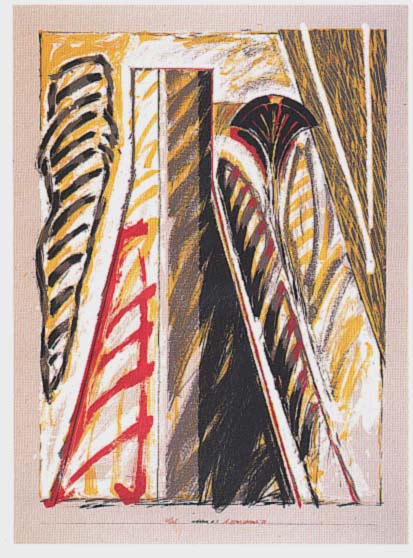
Grand Intérieur I (Machida 167). Original 6-color screenprint, 1988. 45 signed and numbered impressions on heavy gray board plus 5 artist's proofs and 2 HC impressions. Printed and published by Eric Linard. Titus told us that he wanted to see how close he could come to the feel of a painting in a print. Judging from the responses of some of our customers, he came quite close). Image size 1550x1150mm (61-3/16x45-1/4 in.). Price: Please call or email for current pricing information.
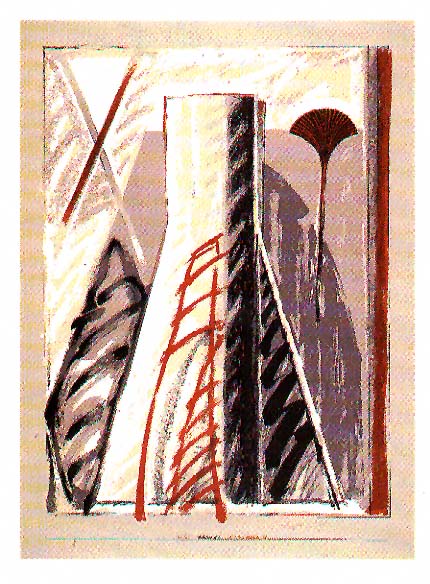
Grand Intérieur II (Machida 168). Original 6-color screenprint, 1988. 45 signed and numbered impressions on heavy gray board plus 5 artist's proofs and 2 HC impressions. Printed and published by Eric Linard. Titus told us that he wanted to see how close he could come to the feel of a painting in a print. Judging from the responses of some of our customers, he came quite close). Image size 1550x1150mm (61-3/16x45-1/4 in.). Price: Please call or email for current pricing information.
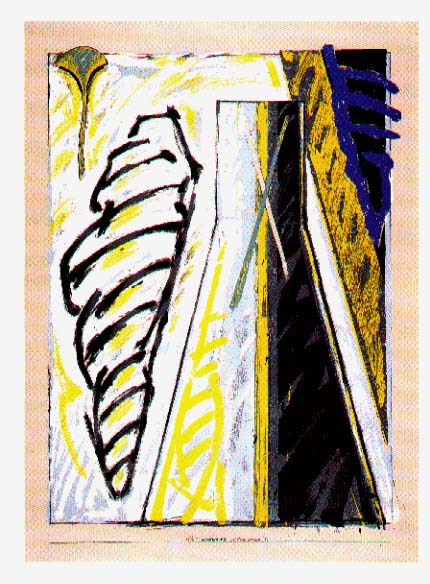
Grand Intérieur III (Machida 169). Original 6-color screenprint, 1988. 45 signed and numbered impressions on heavy gray board plus 5 artist's proofs and 2 HC impressions. Printed and published by Eric Linard. Titus told us that he wanted to see how close he could come to the feel of a painting in a print. Judging from the responses of some of our customers, he came quite close). Image size 1550x1150mm (61-3/16x45-1/4 in.). Price: Please call or email for current pricing information.
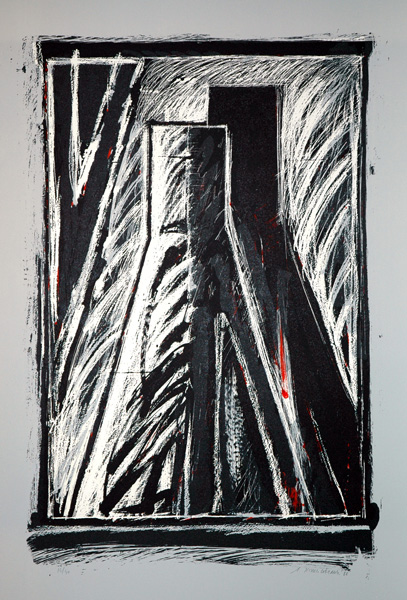
Intérieur noir I (Machida 170). Original color lithograph, 1978. 40 signed & numbered impressions. The Interieurs are one of the larger of Titus' series: 33 paintings, a series of drawings, and 20 prints in varius media. The central images of the series include a monumental track light, crossing verticals, and abstractions of stacked paintings. Image size: 999x700mm (39-3/8x27-9/16 in.). Price: Please call or email for current pricing information.
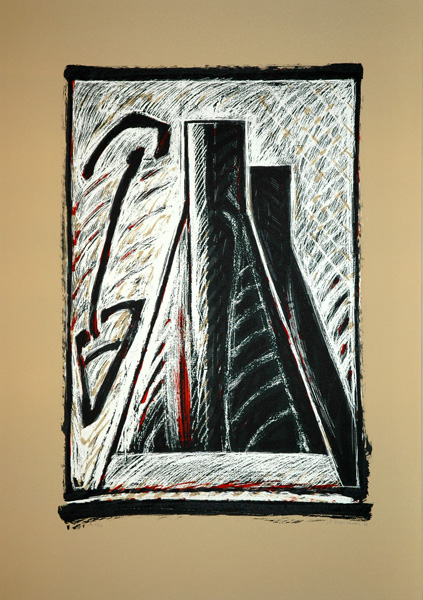
Intérieur noir II (Machida 171). Original color lithograph, 1978. 40 signed & numbered impressions. The Interieurs are one of the larger of Titus' series: 33 paintings, a series of drawings, and 20 prints in varius media. The central images of the series include a monumental track light, crossing verticals, and abstractions of stacked paintings. Image size: 999x700mm. Price: Please call or email for current pricing information.
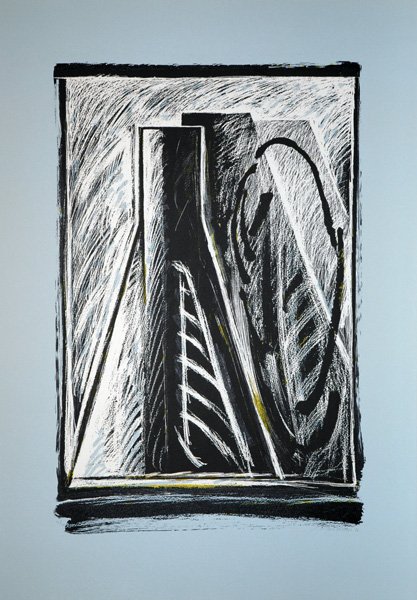
Intérieur noir III (Machida 172). Original color lithograph, 1978. 40 signed & numbered impressions. The Interieurs are one of the larger of Titus' series: 33 paintings, a series of drawings, and 20 prints in varius media. The central images of the series include a monumental track light, crossing verticals, and abstractions of stacked paintings. Image size: 999x700mm. Price: Please call or email for current pricing information.
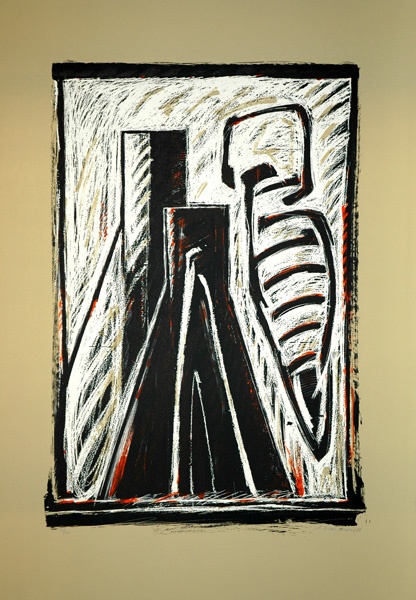
Intérieur noir IV (Machida 173). Original color lithograph, 1978. 40 signed & numbered impressions. The Interieurs are one of the larger of Titus' series: 33 paintings, a series of drawings, and 20 prints in varius media. The central images of the series include a monumental track light, crossing verticals, and abstractions of stacked paintings. Image size: 999x700mm. Price: Please call or email for current pricing information.
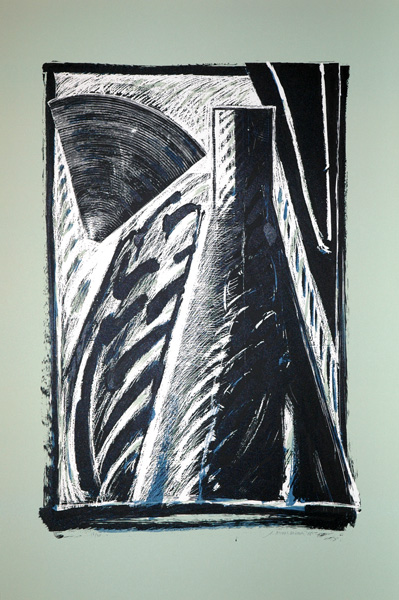
Intérieur noir V (Machida 174). Original color lithograph, 1978. 40 signed & numbered impressions. The Interieurs are one of the larger of Titus' series: 33 paintings, a series of drawings, and 20 prints in varius media. The central images of the series include a monumental track light, crossing verticals, and abstractions of stacked paintings. Image size: 999x700mm. Price: Please call or email for current pricing information.
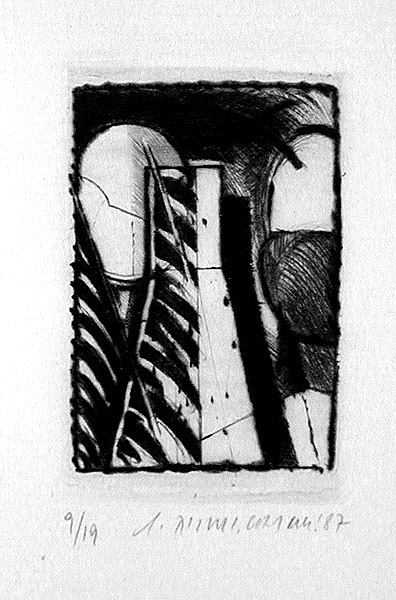
Petit Intérieur I (Machida 161). Original drypoint, 1987. When Titus-Carmel told Aldo Crommelynck that he was leaving for a trip to Japan, Crommelynck suggested that Titus take along a small copper plate and that rather than wasting his time on the plane by reading a book or writing poetry, he make a drypoint. Amused by the challenge, Titus executed this work entirely in drypoint in an edition of 19 signed and numbered impressions. Titus had been working on the series of Intérieur paintings and prints and employed the same central motif but added an airplane window to the composition. Very beautiful and very rare. Image size: 101x69mm Price: SOLD
Spaightwood Galleries owns almost every print Titus-Carmel has made since 1975 (and a few before that), 7 paintings, 4 collages, 7 watercolors, and 8 drawings. If you are interested in a piece we have not yet illustrated on our web-site, please call or e-mail us. In 1992 Spaightwood published Gérard Titus-Carmel: Forging the Real. With 43 illustrations, an insightful essay, a list of one-person exhibitions, and a full but selective bibliography of writings about Titus-Carmel, it’s the best available introduction to his work (up to 1992) in English. Available for only Please call or email for current pricing information.00 plus shipping via priority mail for Please call or email for current pricing information.20.
We also have copies of the 1992 Catalogue Raisonne of his prints published in Tokyo by the Machida Museum with text in Japanese and French and illustrations of every print Titus had made up until the date of its publication (about 200 works). Three thousand copies were printed, and almost all sold in Tokyo. Rare in Europe and America. Mint copies availabe for Please call or email for current pricing information
Spaightwood Galleries, Inc.
To purchase, call us at 1-800-809-3343 (1-508-529-2511 in Upton MA & vicinity) or send an email to spaightwood@gmail.com.
We accept AmericanExpress, DiscoverCard, MasterCard, and Visa.
We also accept wire transfers and paypal.
For directions and visiting information, please call. We are, of course, always available over the web and by telephone (see above for contact information). Click the following for links to past shows and artists. For a visual tour of the gallery, please click here. For information about Andy Weiner and Sonja Hansard-Weiner, please click here. For a list of special offers currently available, see Specials.
All works are sold with an unconditional guarantee of authenticity (as described in our website listing).
Copyright 2004-2017, Spaightwood Galleries, Inc.
Go back to the top of this page.
Visiting hours: Saturday 10:00 am to 5:00 pm and Sunday noon to 6:00 pm and other times by arrangement.
Please call to confirm your visit. Browsers and guests are welcome.








